Riley Bailey
Ukrainian forces continued to advance south of Robotyne in western Zaporizhia Oblast and reportedly advanced near Bakhmut on September 10. Geolocated footage posted on September 10 shows that Ukrainian forces have advanced east of Novoprokopivka (18km southeast of Orikhiv).[1] Ukrainian Tavriisk Group of Forces Spokesperson Oleksandr Shtupun noted that Ukrainian forces continue to advance near Robotyne (12km south of Orikhiv) and have liberated 1.5 square kilometers of territory in this direction.[2] The Ukrainian General Staff and Ukrainian Eastern Group of Forces Spokesperson Ilya Yevlash reported that Ukrainian forces achieved unspecified success near Klishchiivka (7km southwest of Bakhmut) in Donetsk Oblast.[3]
Ukrainian Main Military Intelligence Directorate (GUR) Head Kyrylo Budanov stated on September 10 that Ukrainian forces will continue counteroffensive operations into late 2023.[4] Cold and wet weather will affect but not halt active combat, as it has done in the first 18 months of the war. Chairman of the US Joint Chiefs of Staff General Mark Milley stated on September 10 that Ukrainian forces probably have 30 to 45 days of “fighting weather” left.[5] Seasonal heavy rains and heavy mud in late autumn will slow ground movements for both sides, and low temperatures impose a variety of logistics challenges. The start of such seasonal weather is variable, however.[6] While weather considerations will affect Ukrainian counteroffensive operations, they will not impose a definite end to them. A hard freeze occurs throughout Ukraine in the winter that makes the ground more conducive to mechanized maneuver warfare, and Ukrainian officials expressed routine interest in exploiting these weather conditions in winter 2022–2023.[7]
Russian military personnel continue to detail persistent problems hindering Russian operations along the frontline in Ukraine. The “Rusich” Sabotage and Reconnaissance Group, a far-right Russian irregular paramilitary unit, published a list of various issues on September 8 that it claims are persistent along the frontline. Rusich claimed that Russian counterbattery range and accuracy are inferior to Ukrainian capabilities and claimed that Russian forces lack laser-guided Krasnopol shells and UAVs to guide them.[8] The Rusich Group also claimed that the Russian Tornado-S multiple launch rocket system (MLRS) is less resistant to electronic warfare (EW) than Ukraine’s US-provided HIMARS systems.[9] The Rusich Group also noted that many Russian personnel buy their own communication technology, making it difficult for different units using different models of technology to communicate with each other.[10] The Rusich Group claimed that Russian forces do not evacuate wounded or dead personnel from frontline areas, and that this lack of evacuations has prompted some Russian personnel to refuse to complete combat tasks.[11] The Rusich Group may be experiencing these problems at a higher intensity and frequency than Russian forces writ large because it is a small and irregular formation, but ISW has routinely observed other Russian units expressing similar issues with counterbattery capabilities, communications, and evacuations.[12]
Russian forces conducted a series of Shahed-131/-136 drone strikes targeting Kyiv Oblast on the night of September 9 to 10. Ukrainian military sources reported on September 10 that Ukrainian forces downed 26 of 33 drones that Russian forces launched from the direction of Kursk Oblast.[13] Ukrainian Air Force Spokesperson Colonel Yuriy Ihnat stated that Russian forces dispersed the Shahed drones in the air and attacked targets from different directions in order to complicate Ukrainian air defense operations.[14] Kyiv Oblast Administration Head Ruslan Kravchenko stated that Russian strikes damaged an infrastructure facility, a school, residential buildings, and a rehabilitation center in Kyiv Oblast.[15] Russian milbloggers claimed that NASA FIRMS/VIIRS data suggests that Russian forces struck a Ukrainian military arsenal in Rokytnyanskyi Raion, Kyiv Oblast.[16]
Army General Sergei Surovikin, the previously dismissed Wagner-affiliated former commander of Russia’s Aerospace Forces (VKS), has reportedly become the head of the Coordination Committee on Air Defense Issues under the Council of Defense Ministers of the Commonwealth of Independent States (CIS). Several low-profile and local Russian outlets reported on September 10 that the CIS Council of Defense Ministers unanimously voted on Surovikin’s appointment to head of the air defense committee, and noted that Surovikin will now be responsible for overseeing the function of the joint air defense system of CIS member states.[17] More mainstream and Kremlin-affiliated newswires notably did not report on Surovikin’s new appointment and have not mentioned Surovikin at all since Russian President Vladimir Putin dismissed him as VKS commander on August 23.[18] ISW previously assessed that Surovikin’s move to a leadership position with the CIS is consistent with previous patterns of the Russian military leadership shifting disgraced and ineffective commanders to peripheral positions far removed from Ukraine without discharging them from the Russian military entirely.[19]
Russia held the final day of voting for regional elections on September 10 amid reports of electoral falsifications and intimidation. Affiliates of imprisoned ultranationalist Igor Girkin claimed that Russian officials falsified all electoral results in Nakhodka, Primorsky Krai, and attacked an independent candidate in Saratov, Saratov Oblast.[20] Girkin’s affiliates noted that Russian officials coerced people to vote to improve voter turnout but that average turnout will likely be at 35 percent.[21] The Radio Free Europe/Free Liberty (RFE/RL) branch Sever Realii reported that Russian authorities detained three Yabloko Party candidates in Veliky Novgorod, Novgorod Oblast.[22] Russian sources also reported that Kremlin newswire RIA Novosti published the results of the regional elections in the Republic of Sakha before the closure of the polls there.[23] RFE/RL branch Idel Realii reported that Russian authorities issued a military summons to a Communist Party candidate in the Republic of Bashkortostan when he visited a polling station.[24]
Russian sources claimed that the Russian peacekeeping contingent in Nagorno-Karabakh has not conducted personnel rotations due to increasing tension between Armenia and Azerbaijan.[25] The Russian sources also claimed that the Russian peacekeeping contingent is on “full alert” because of the potential escalation between Armenian and Azerbaijani forces.[26] Russian sources will likely increasingly discuss the situation in Nagorno-Karabakh if hostilities between Armenia and Azerbaijan intensify, which may impact their coverage of the war in Ukraine.
Key Takeaways:
- Ukrainian forces continued to advance south of Robotyne in western Zaporizhia Oblast and reportedly advanced near Bakhmut on September 10.
- Ukrainian Main Military Intelligence Directorate (GUR) Head Kyrylo Budanov stated on September 10 that Ukrainian forces will continue counteroffensive operations into late 2023. Cold and wet weather will affect but not halt active combat, as it has done in the first 18 months of the war.
- Russian military personnel continue to detail persistent problems hindering Russian operations along the frontline in Ukraine.
- Russian forces conducted a series of Shahed-131/-136 drone strikes targeting Kyiv Oblast on the night of September 9 to 10.
- Russian forces conducted offensive operations along the Kupyansk-Svatove-Kreminna line, near Bakhmut, along the Avdiivka-Donetsk City line, in the Donetsk-Zaporizhia Oblast border area, and in western Zaporizhia Oblast and reportedly regained some lost positions in some areas.
- Ukrainian Main Intelligence Directorate (GUR) Spokesperson Major General Vadym Skibitskyi stated on September 10 that the Russian military has concentrated over 420,000 military personnel in occupied Ukraine, not including Rosgvardia (Russian national guard) and other military units and structures.
- Russian occupation officials held the final day of voting for Russian regional elections in occupied territories on September 10, continuing efforts to coerce residents to vote and portray the elections as legitimate.
- Russian Main Effort – Eastern Ukraine (comprised of two subordinate main efforts)
- Russian Subordinate Main Effort #1 – Capture the remainder of Luhansk Oblast and push westward into eastern Kharkiv Oblast and encircle northern Donetsk Oblast
- Russian Subordinate Main Effort #2 – Capture the entirety of Donetsk Oblast
- Russian Supporting Effort – Southern Axis
- Russian Mobilization and Force Generation Efforts
- Activities in Russian-occupied areas
Russian Main Effort – Eastern Ukraine
Russian Subordinate Main Effort #1 – Luhansk Oblast (Russian objective: Capture the remainder of Luhansk Oblast and push westward into eastern Kharkiv Oblast and northern Donetsk Oblast)
Russian forces reportedly continued offensive operations along the Kupyansk-Svatove-Kreminna line but did not make any confirmed advances on September 10. Russian sources claimed on September 9 that Russian forces conducted offensive operations near Synkivka (9km northeast of Kupyansk), Petropavlivka (7km east of Kupyansk), and in the direction of Kyslivka (20km southeast of Kupyansk).[27]A Russian milblogger claimed that Russian forces conducted offensive operations near Novoyehorivka (16km southwest of Svatove) and in the direction of Serebryanka (14km southwest of Kreminna).[28] Russian sources claimed that Russian and Ukrainian forces skirmished near Novoselivske (15km northwest of Svatove), Karmazynivka (13km southwest of Svatove), and in the forests west of Kreminna.[29] Geolocated footage published on September 6 indicates that Russian forces advanced south of Kreminna sometime in August.[30]
Ukrainian forces reportedly conducted ground attacks along the Kupyansk-Svatove-Kreminna line but did not make any confirmed advances on September 10. The Russian Ministry of Defense (MoD) claimed that Russian forces repelled Ukrainian attacks near Kuzemivka (13km northwest of Svatove) and Dibrova (7km southwest of Kreminna).[31] A Russian milblogger claimed that Ukrainian forces attacked near Synkivka.[32] Geolocated footage published on September 6 indicates that Ukrainian forces advanced south of Kreminna sometime in August.[33]
Russian Subordinate Main Effort #2 – Donetsk Oblast (Russian objective: Capture the entirety of Donetsk Oblast, the claimed territory of Russia’s proxies in Donbas)
Ukrainian forces conducted offensive operations near Bakhmut on September 10 and reportedly advanced. The Ukrainian General Staff and Ukrainian Eastern Group of Forces Spokesperson Ilya Yevlash stated that Ukrainian forces achieved unspecified success near Klishchiivka (7km southwest of Bakhmut).[34] The Ukrainian 2nd Mechanized Battalion of the 3rd Assault Brigade stated on September 9 that it had pushed Russian forces out of an unspecified area in the Bakhmut direction.[35] A Russian milblogger claimed on September 9 that fighting was ongoing near Andriivka (9km southwest of Bakhmut) and Kurdyumivka (13km southwest of Bakhmut).[36]
Russian forces conducted offensive operations near Bakhmut on September 10 but did not make confirmed or claimed advances. The Ukrainian General Staff reported that Russian forces conducted unsuccessful offensive operations near Berestove (25km northeast of Bakhmut), Orikhovo-Vasylivka (11km northwest of Bakhmut), Bohdanivka (5km northwest of Bakhmut), Klishchiivka, and Kurdyumivka.[37] Russian sources claimed on September 9 that Russian forces attacked near Dubovo-Vasylivka (6km northwest of Bakhmut) and improved their positions near the Berkhivka Reservoir (about 2km north of Bakhmut).[38] A Russian milblogger published footage on September 10 purportedly showing elements of the 57th Motorized Rifle Brigade (5th Combined Arms Army, Eastern Military District) operating near Kurdyumivka.[39] The milblogger also claimed that elements of the 83rd Guards Air Assault (VDV) Brigade and 11th VDV Brigade are operating in the Bakhmut direction.[40] Footage published on September 10 purportedly shows artillery units of the 106th VDV Division operating near Bakhmut.[41]
Russian forces conducted offensive operations along the Avdiivka-Donetsk City line on September 10 but did not make any confirmed or claimed advances. The Ukrainian General Staff reported that Ukrainian forces repelled Russian attacks near Keramik (14km northwest of Avdiivka), Avdiivka, and Marinka (on the southwestern outskirts of Donetsk City).[42] A Russian milblogger claimed that Russian forces unsuccessfully attacked near Krasnohorivka (22km southwest of Avdiivka).[43]
Ukrainian forces conducted offensive operations along the Avdiivka-Donetsk City line on September 10 and reportedly advanced. Avdiivka City Military Administration Head Vitaliy Barabash stated that Ukrainian forces gained a foothold in Opytne on September 8 (3km southwest of Avdiivka) and that fighting is ongoing in the settlement.[44] A Russian milblogger claimed that the situation in Opytne is not easy, and that fighting is ongoing in urban areas.[45] The Russian Ministry of Defense (MoD) claimed that Russian forces repelled Ukrainian attacks near Vodyane (7km southwest of Avdiivka) and Krasnohorivka.[46]
Russian Supporting Effort – Southern Axis (Russian objective: Maintain frontline positions and secure rear areas against Ukrainian strikes)
Russian sources claimed that Ukrainian forces continued offensive operations in the Donetsk-Zaporizhia Oblast border area on September 10 but did not advance. Russian milbloggers largely reported that Ukrainian forces continued ground attacks along the Novodonetske—Novomayorske line (13–18km southeast of Velyka Novosilka).[47] One milblogger reported that Russian forces repelled three Ukrainian armored attacks along this line overnight.[48] Russian sources additionally claimed that positional battles are continuing near Urozhaine and Staromayorske, both about 10km south of Velyka Novosilka.[49]
Russian sources claimed that Russian forces conducted limited counterattacks in the Donetsk-Zaporizhia Oblast border area on September 10 and reportedly regained some lost positions. Russian milbloggers claimed that Russian forces are expanding their zone of control near Pryyutne, about 16km southwest of Velyka Novosilka, following successful counterattacks in the area on September 9.[50] A Russian milblogger additionally claimed that Russian forces counterattacked near Novomayorske and regained unspecified positions.[51]
Ukrainian forces continued offensive operations in western Zaporizhia Oblast and advanced on September 10. Geolocated footage posted on September 10 shows that Ukrainian forces have made gains east of Novoprokopivka (18km southeast of Orikhiv).[52] Ukrainian Tavriisk Group of Forces Spokesperson Oleksandr Shtupun noted that Ukrainian forces continue to advance near Robotyne (12km south of Orikhiv) and have liberated 1.5 square kilometers of territory in this direction.[53] Russian milbloggers additionally reported that Ukrainian forces continued attacking along the Robotyne–Verbove line, particularly near Novoprokopivka.[54] One Russian milblogger noted that Ukrainian forces also attacked Kopani (12km southwest of Orikhiv) from the east.[55] The sector of the front west of Robotyne has notably been quieter in recent weeks, and reports of Ukrainian activity in this area may represent renewed attempts to attack southwest of Orikhiv.
Russian sources continued limited counterattacks in western Zaporizhia Oblast on September 10 and reportedly regained some lost positions. The Ukrainian General Staff reported that Russian forces unsuccessfully attacked near Robotyne.[56] Some Russian milbloggers claimed that Russian forces counterattacked northwest of Verbove and regained some previously lost positions.[57]
Russian sources claimed that Russian forces thwarted a Ukrainian special operations group in the Black Sea on the night of September 9 to 10. The Russian Ministry of Defense (MoD) claimed that Russian naval aviation discovered and destroyed three Ukrainian boats carrying a total of 36 special operations servicemen northeast of Snake Island, Odesa Oblast that were traveling in the direction of occupied Crimea.[58] A milblogger claimed that Ukrainian intelligence agents initially launched six boats towards Cape Tarkhankut and that a Russian Su-24M naval aviation bomber dropped four cluster bombs and sunk three of the boats, forcing the remaining three to retreat.[59]
Russian sources claimed that Ukrainian forces attempted to attack occupied Crimea with drones on the night of September 9 to 10. The Russian MoD claimed that Russian air defense downed eight Ukrainian drones over the Black Sea near the Crimean coast overnight on September 9 to 10.[60] A Russian milblogger claimed that Ukrainian forces were attempting to target military assets on Cape Tarkhankut and noted that units of the 31st Air Defense Division shot down eight of the drones.[61]
Russian Mobilization and Force Generation Efforts (Russian objective: Expand combat power without conducting general mobilization)
Ukrainian Main Intelligence Directorate (GUR) Spokesperson Major General Vadym Skibitskyi stated on September 10 that the Russian military has concentrated over 420,000 military personnel in occupied Ukraine, not including Rosgvardia (Russian national guard) and other military units and structures; thus this number does not fully reflect Russia’s total forces involved in the war in Ukraine.[62] Ukrainian Defense Minister Rustem Umerov stated that there are currently one million active Ukrainian Defense Forces personnel, with 800,000 serving in the ranks of the Armed Forces, though this number similarly does not mean 800,000 Ukrainian personnel are actively engaged in fighting.[63]
Russian defense enterprise Uralvagonzavod General Director Alexander Potapov stated on September 10 that the Sverdlovsk Oblast–based machine building company is planning on producing T-80VM tanks.[64] Potapov stated that Uralvagonzavod is actively interacting with the Russian Ministry of Industry and Trade to establish new capacities at the plant to produce the latest modification of the T-80 main battle tank.[65] Russian opposition outlet Novaya Gazeta reported in November 2022 that Uralvagonzavod could produce 200 to 250 new T-90 and T-72 tanks a year and could repair up to 600 damaged tanks a year in partnership with Omsktransmash in Omsk Oblast.[66]
The United Kingdom Ministry of Defense (UK MoD) reported on September 10 that Pskov Oblast Governor Mikhail Vedernikov has organized volunteer security patrols to interdict possible further drones strikes against the Kresty airfield, where Ukrainian forces reportedly damaged four Russian IL-76 aircraft on August 29.[67] The UK MoD added that the volunteer patrols will consist of 50 people divided among multiple municipalities.[68]
Activities in Russian-occupied areas (Russian objective: Consolidate administrative control of annexed areas; forcibly integrate Ukrainian citizens into Russian sociocultural, economic, military, and governance systems)
Russian occupation officials held the final day of voting for Russian regional elections in occupied territories on September 10, continuing efforts to coerce residents to vote and portray the elections as legitimate.[69] Ukrainian officials reported that Russian occupation officials continue to go door-to-door to force people to vote and that occupation police officers watch people at polling stations to see which candidates they vote for.[70] Ukrainian Kherson Oblast Deputy Chairman Yurii Sobolevskyi stated that Russian occupation officials are trying to reach a pre-determined turnout figure of 75 to 80 percent.[71] Zaporizhia Oblast occupation deputy Vladimir Rogov claimed that voter turnout was already at 53 percent in occupied Zaporizhia Oblast.[72] The Kherson Oblast occupation administration amplified a post on September 10 claiming that the ruling United Russia Party already has roughly 73 percent of the vote in occupied Kherson Oblast, 84 percent in occupied Zaporizhia Oblast, 75 percent in occupied Luhansk Oblast, and 79 percent in occupied Donetsk Oblast.[73] Russian occupation officials and sources also continued to promote the work of “international election observers” to claim that there have been no electoral violations.[74] Russian occupation officials will likely publish inflated turnout statistics to portray the elections as legitimate, and these figures will likely ignore the demographic ramifications of forced depopulation of many areas of occupied Ukraine.[75]
Russian officials accused Ukrainian forces of disrupting regional elections on September 10, likely to set informational conditions to explain possible reports of low voter turnout. Russian Central Election Commission (CEC) Head Nikolai Bulaev accused Ukrainian forces of destroying a polling station in occupied Zaporizhia Oblast with a drone strike and conducting missile strikes near occupied Henichesk, Kherson Oblast on September 10 to disrupt regional elections.[76] Kherson Oblast occupation commission chairperson Marina Zakharova stated that Russian occupation officials closed polling stations early in occupied Nova Kakhovka and Kakhovka due to Ukrainian shelling.[77]
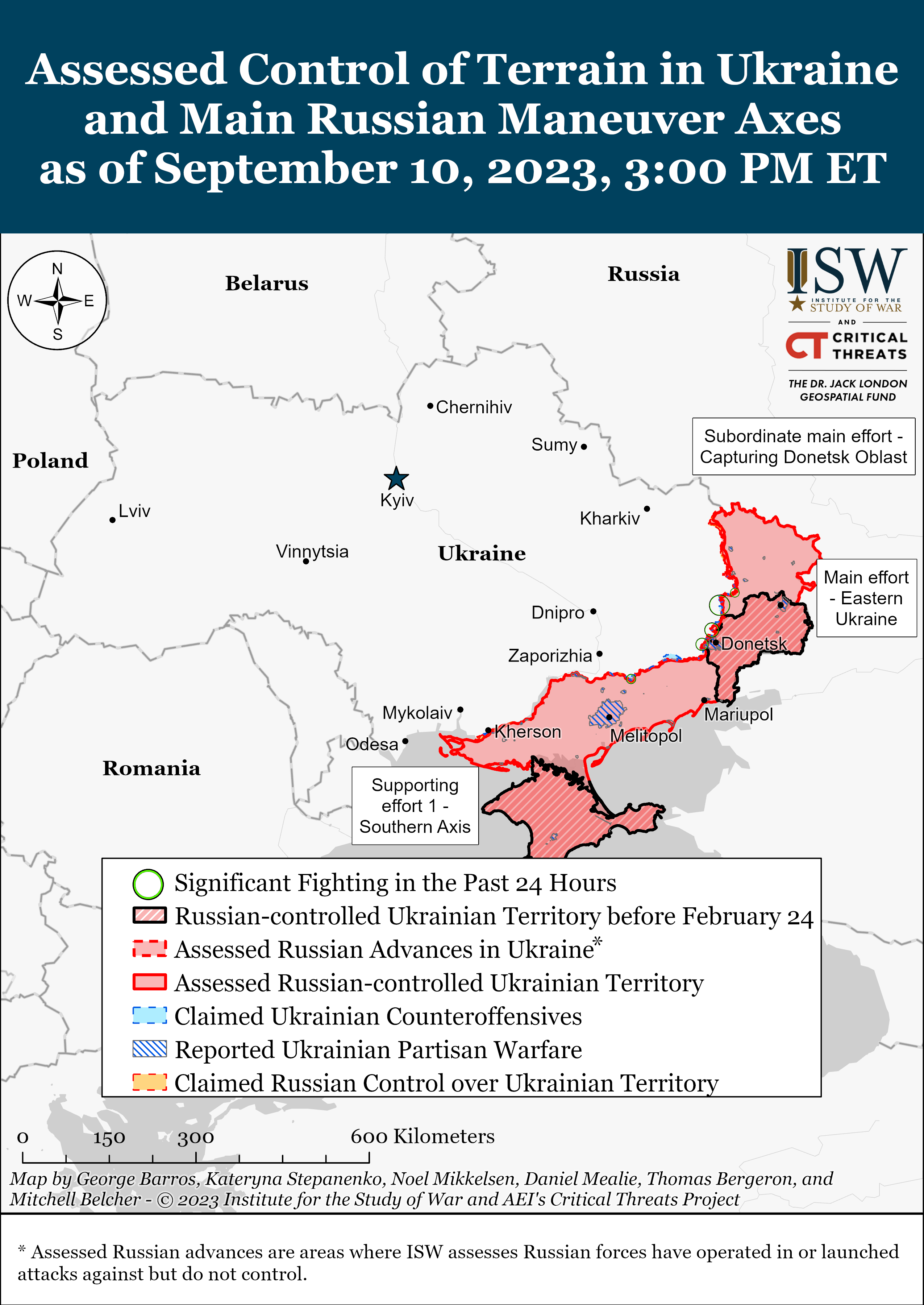
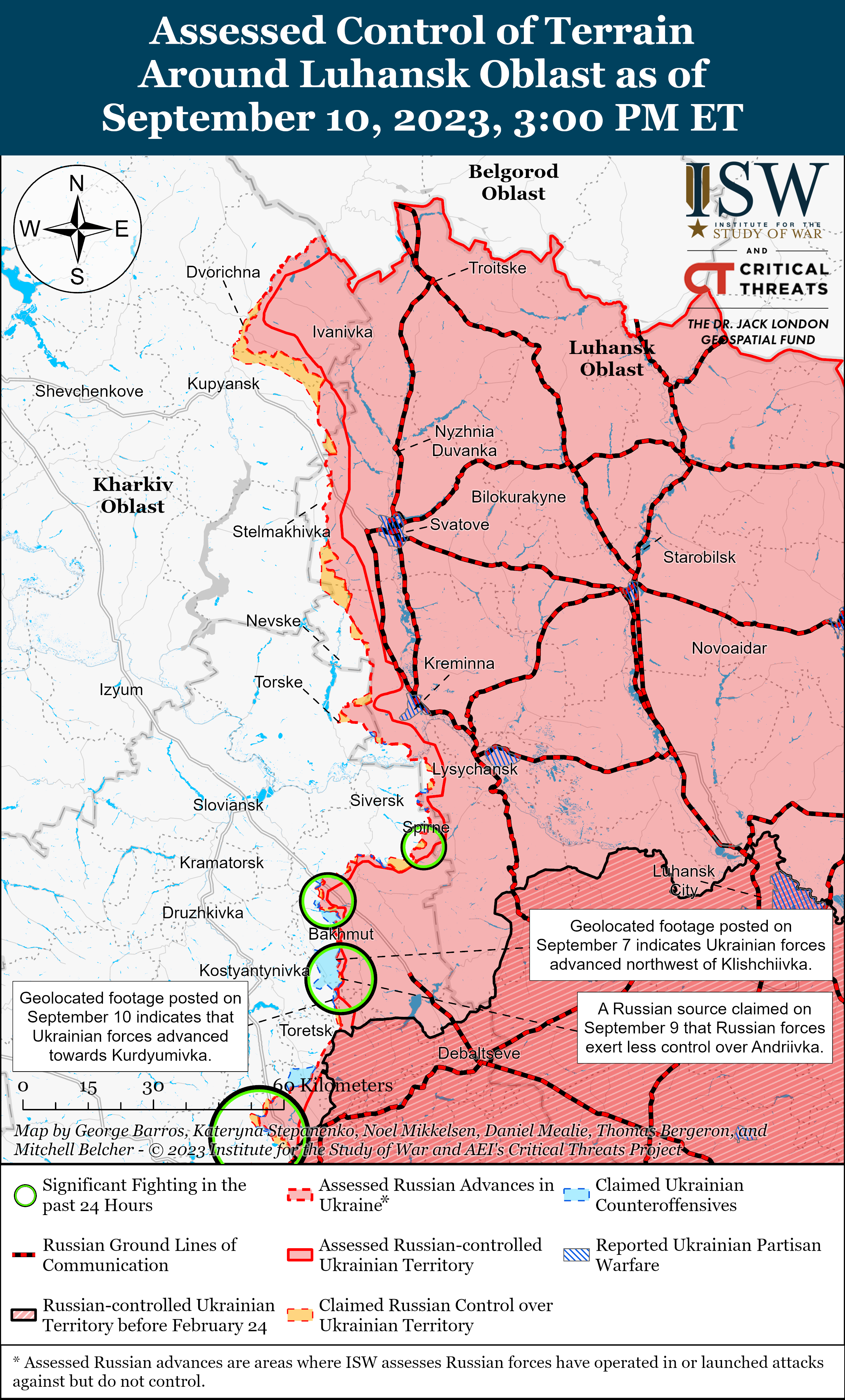
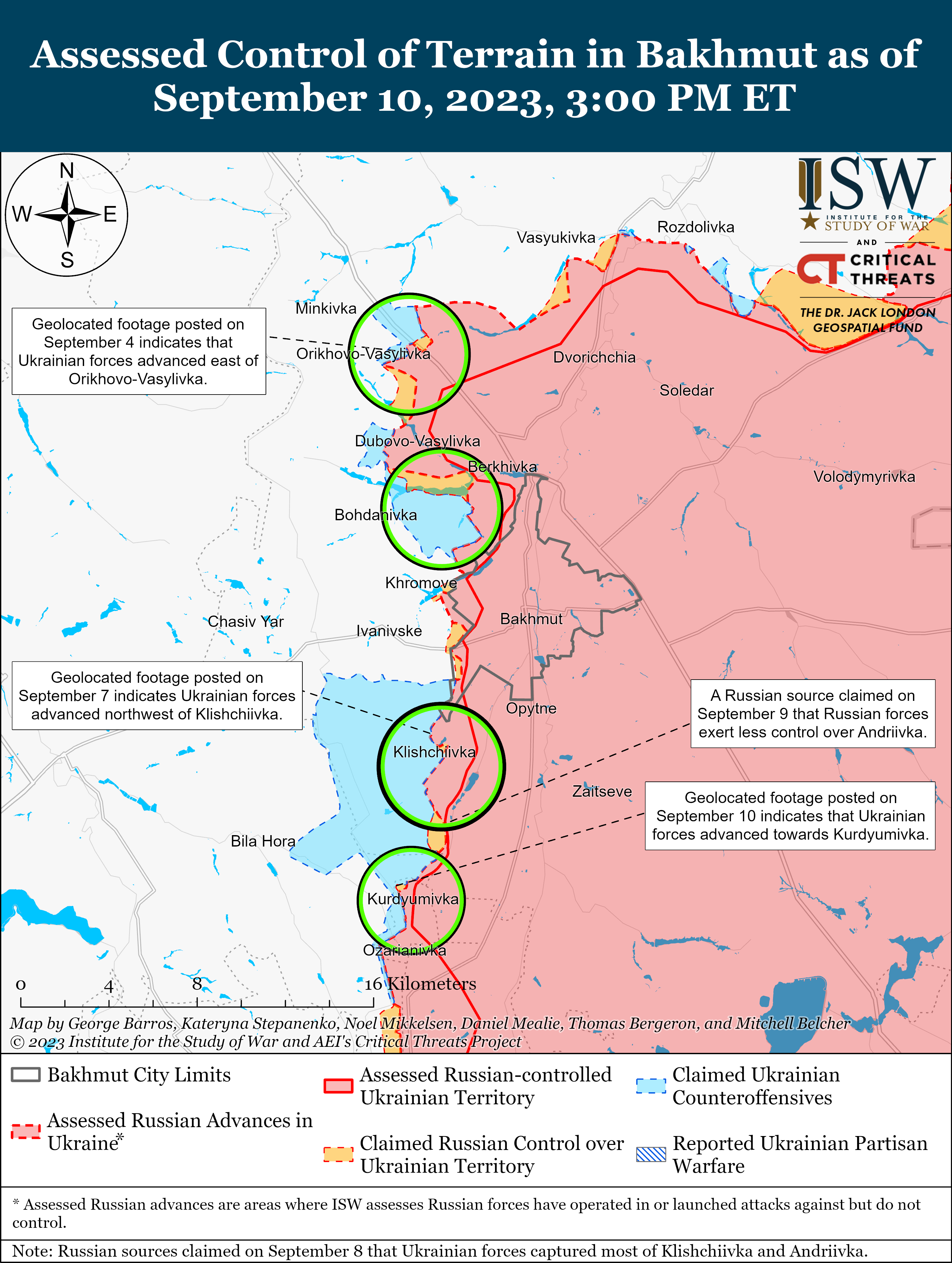
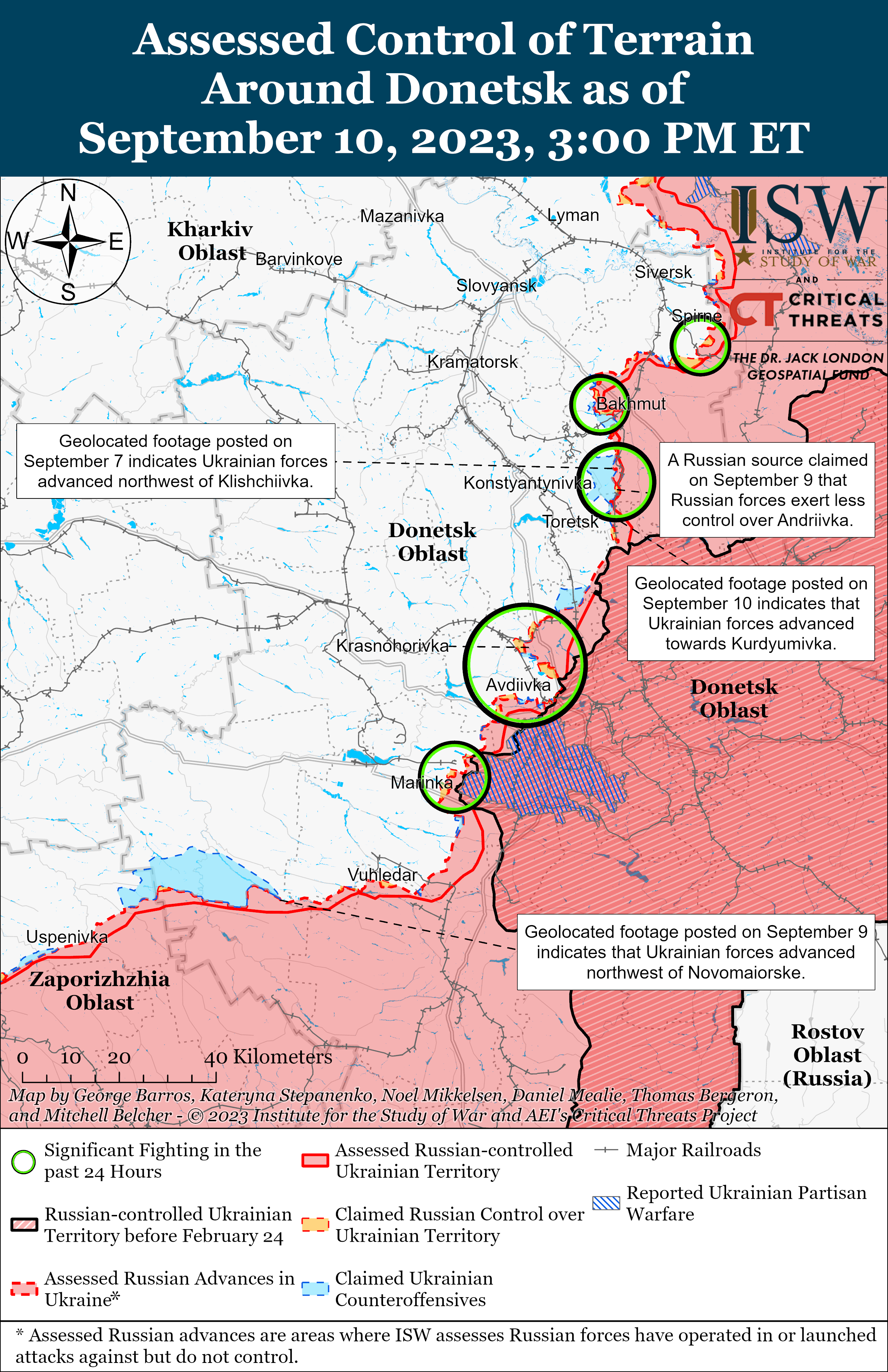
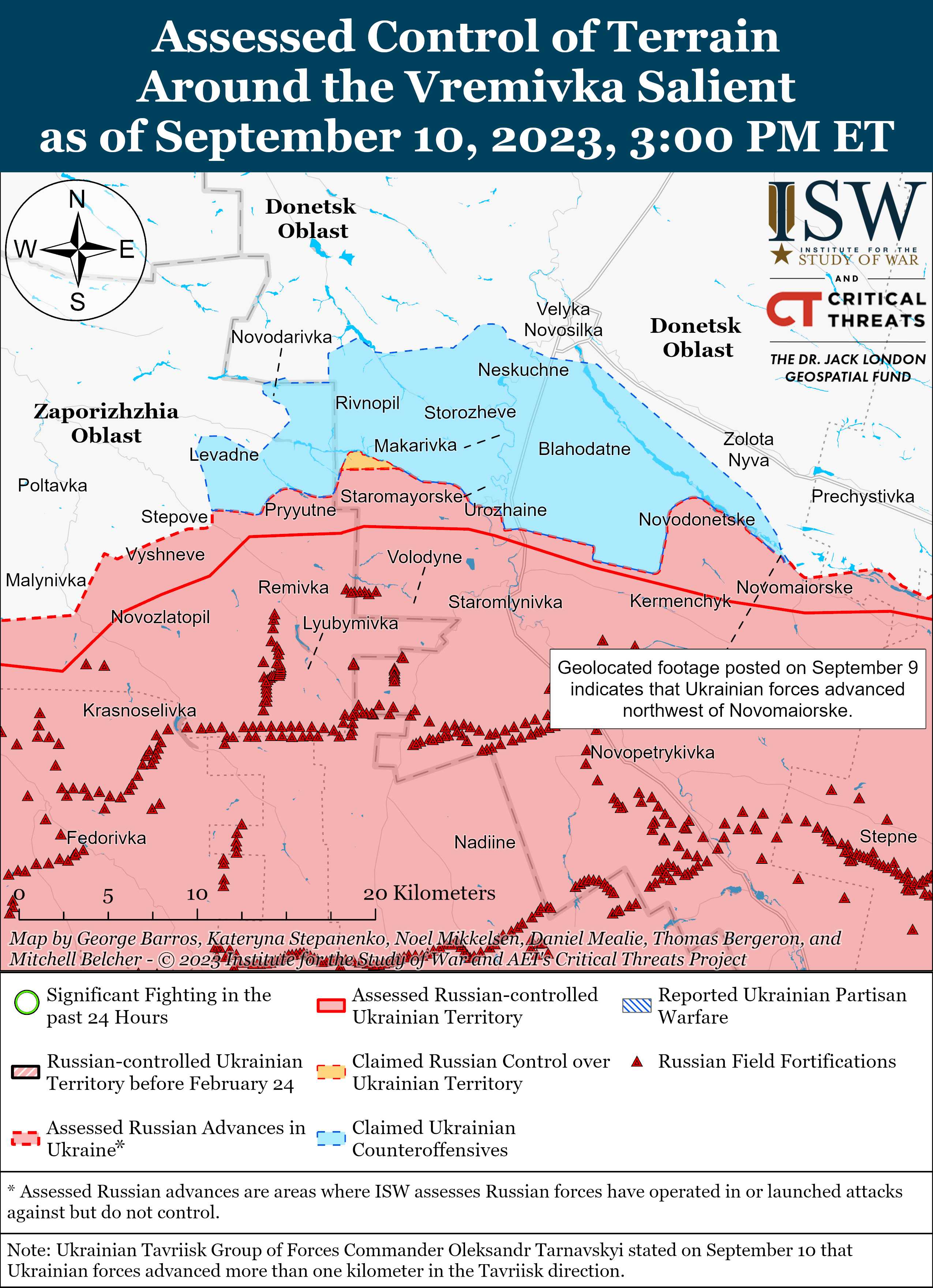
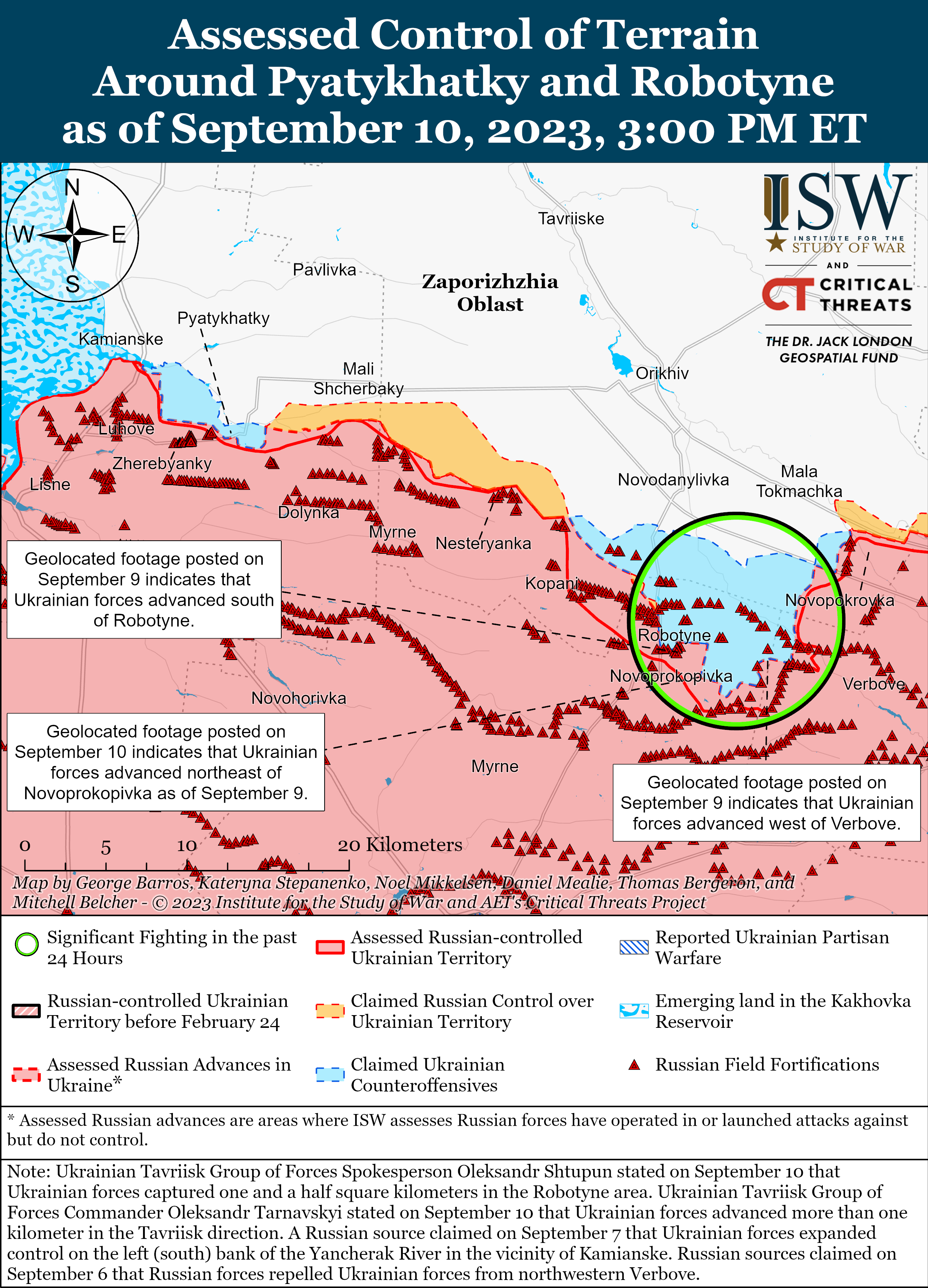
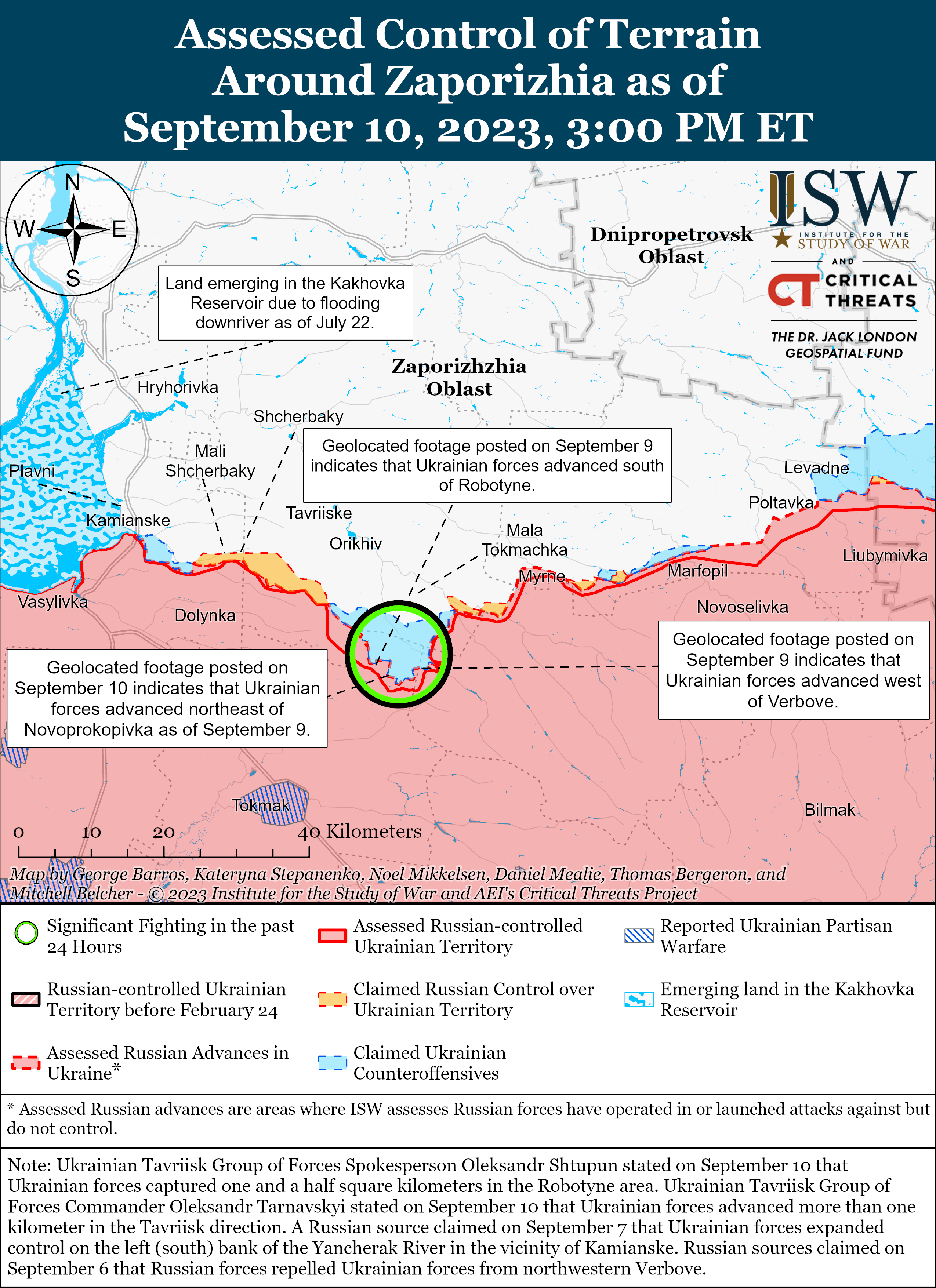
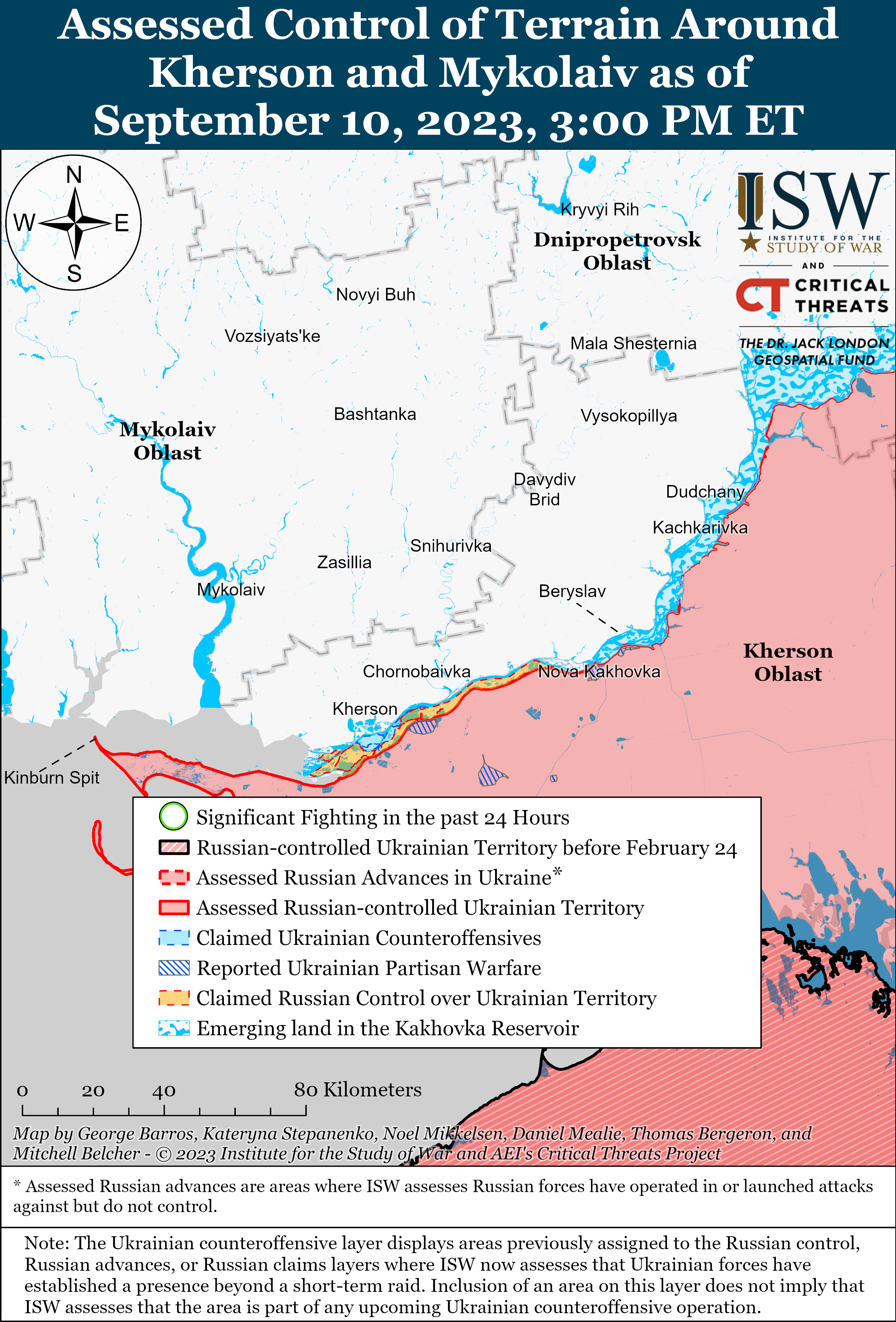
No comments:
Post a Comment